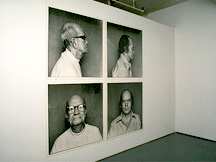- MAIN INDEX | ARTIST INDEX
| October 29 - November 21, 1992 Series #2 in the Project Room
| |
 Arnaud Maggs, installation view "Charlie and His Son Jim", 1978. Photo Peter MacCallum. 18K |  Lisa Steele, "Birthday Suit - with Scars and Defects", video (on monitor) 1974; Arnaud Maggs, "Identical Twins", 1978. Photo Peter MacCallum. 18K |
|
Brochure Text: This exhibition examines the staging of the body in relation to the viewer. That is to say, in these works the body is presented as a site of representational investigation - not only as material object, but also as a manifestation of history and identity. The photographs by Arnaud Maggs and video tape by Lisa Steele are documentaries which foreground their construction. Their insistence on material truths and their explication of the body's inextricable incorporation of complex issues of identity and cultural experience make these compelling early examples of works which interrogate representations of individual subjectivity - documentaries of human beings in experiential rather than essentialist terms: These investigations into historicized subjectivity were informed in the mid-seventies by the burgeoning influence of psychoanalytic theory and feminism, as well as theoretical discourse identifying subjectivity as produced in and by representation. While Steele's radical feminist vision politicizes the gender of the spectator and the space of the spectacle itself, Maggs subverts the modernist anonymity of the grid with the evidence of lived individual experience - calling into question cannons of traditional art forms. Steele's work, Birthday Suit - with scars and defects, produced in 1974, documents time written on the body - experience as the index of personal history marked on both physicality and subjectivity. In this black and white tape, Steele directly addresses a stationary camera which records her in real time in an emptied domestic interior. Opening with a close-up shot of her-thighs, she states that on the occasion of her twenty-seventh birthday, she is going to show us her "birthday suit with scars and defects": By moving closely in front of the lens, she isolates parts of her naked body in its frame, tracing and retracing with her finger, the marks of injuries she has sustained through her life. The scars are displayed in chronological order as Steele inventories the date and circumstance of the injury as well as her age at the time . of the event. This close scrutiny is bracketed at the beginning and end of the tape by Steele walking away. from the camera and turning to reveal herself from each side in a "long shot'' which counters the titillating effects of the typical fragmentation: of pornography and the fetishizing voyeuristic gaze. She places her body in the space itself, turning the gaze in on itself. Through an accumulation of facts, the tape constructs a catalogue which builds over time but refuses an imposition of the linearity and compressed-time of classical narrative. The fixed position of the lens and the absence of cuts or dissolves in tile tape makes the camera's presence in the room clear and insists on the lack of another controlling body behind it. Steele makes visually explicit the objective construction of her own history and affirms women's autobiography as a legitimate form of discourse. Maggs' work of the mid-seventies shares Steele's use of the documentary form, and also employs the body as a site of representation. However, in his works Charlie and his Son Jim and Identical Twins, both from 1978, Maggs positions himself behind the camera in a more familiar structure of photographic authorship and representation. This authorship is foregrounded by the imposition of the obvious visual structure of the modernist grid. These larger-than-life, black and white portraits detail the familial resemblance between twin brothers and a father and his son. The air of clinical detachment that these highly detailed, sharply focused photographs create is emphasised by the rational symmetry of their presentation. In each work a paired front view and right profile of two men are displayed as a gridded quadrant - a format of multiple views which segment the space of the gaze. While individually these still photographs imply a continuous unbroken stare, Maggs' fragmentation of the photographic image necessitates a kind of durational reading. The spatial structure of the grid, however, rejects the possibility of accumulating all of the precisely displayed visual information into a sequential narrative. As a documentation of visual difference and similarity, the photographs resist the subjective interpretation or speculation which traditional portrait photography would suggest. For instance, Identical Twins presents brothers who were separated at birth and raised in vastly: different cultural communities who found each later in life. But the viewer is left to construct an observation of the body as material thing: one which might account for both the difference of cultural experience and age, or the obvious similarities produced by a shared genetic code. These early works by Maggs and Steele are important examples of representational investigations into issues of identity. With their rigorous critiques of the socialised aspects of identity, works such as these began to shift the emphasis of local discourse away from the hermetically reflexive conceptual work preceding, to the media conscious appropriation strategies of work which was to follow during the eighties. The technology that the works in this exhibition employ is seen in its most reduced form, documenting intimate rather than social space. Representational technology foregrounds the parameters of the works' construction, affirming their authorship as grounded not in an autonomous vision, but rather in history. -Sharon Brooks
| |